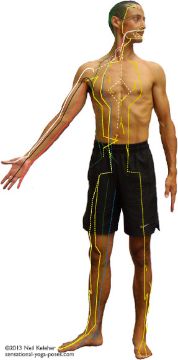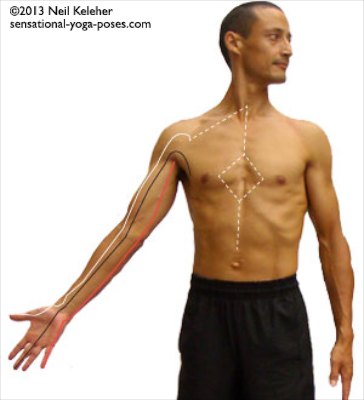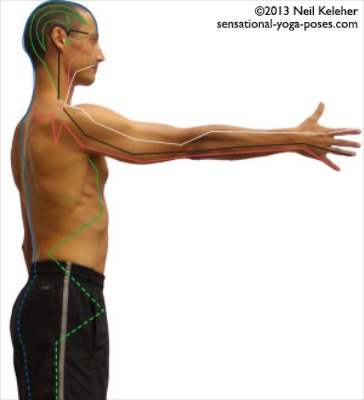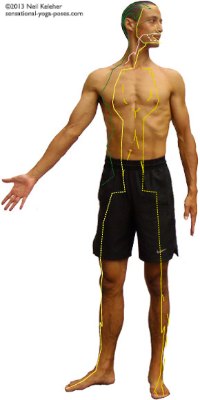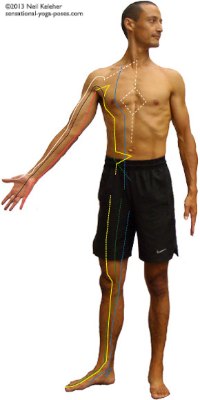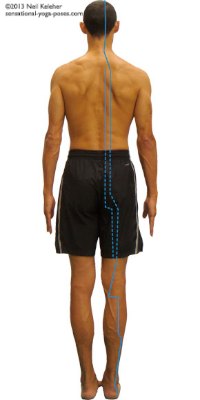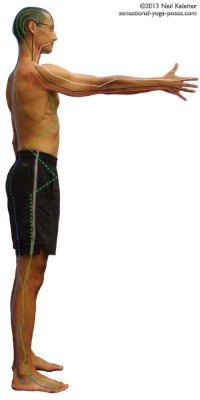Meridian Flow Specifics
Lung and Large Intestine
Lung-Large Intestine
Metal-White
Usually the starting point for the meridian circuit is the lung meridian. The lung meridian runs down the outside of the front of the arm. It connects to the large intestine meridian which runs up the outside of the back of the arm and up the side of the neck.
Both of these meridians are associated with the metal element and are colored white in the pictures.
Stomach and Spleen
Stomach-Spleen
Earth-Yellow
The large intestine meridian connnects to the stomach meridian which runs from the face down the neck and the front of the body and front of the thigh to the foot. There it connects to the spleen meridian which runs up the front of the inner thigh, up the front of the body along the outside of the stomach meridian.
Both these meridians are associated with the earth element and are colored yellow in the pictures.
Heart and Small Intestine
Heart-Small Intestine
Fire-Red
The spleen meridian connects to the heart meridian near the shoulder. The heart meridian runs down the inside of the front of the arm and connects to the small intestine meridian at the fingers.
The small intestine meridian runs up the inside of the back of the arm and then from there up the side of the neck.
Both of these meridians are associated with the fire element and are colored red in the diagrams.
Bladder and Kidneys
Bladder-Kidney
Water-Blue
The small intestine meridian connects to the bladder meridian which runs down the back of the neck, body and legs. It connects to the kidney meridian at the feet. The kidney meridian runs up the back of the inner thigh, up the front of the body inside the two lines of the stomach meridian.
Both these meridians are associated with the water element and are colored blue in the diagrams.
Pericardium and Triple Heater
Pericardium-Triple Heater
(No Element)-Black
The kidney meridian connects to the pericardium meridian which runs down the center of the front of the arm. The triple heater meridian runs up the center of the back of the arm and from there runs up the side of the neck and head.
Both have no associated element and are colored black.
Gall Bladder and Liver
Gall Bladder-Liver
Wood-Green
The triple heater meridian connects to the gall bladder meridian which runs down the side of the neck, along the front of the shoulder and down the side of the body and leg. It connects to the liver meridian which runs up the center line of the inner thigh and up the sides of the body where it eventually completes the meridian circuit by connecting to the lung meridian.
Both meridians are associated with the wood element and are colored green in the meridian diagrams.
Send Your Organs a Smile
I will say this. Accepting that the meridians do have some connection to the organs gives me an excuse to spend some time visualizing my organs and sending them love or light, or as Mantak Chia and one of his students suggest (at least the one that I've read) send them a smile.
I know for a fact that when someone smiles at me I feel good, particularly if it is someone I like. And likewise I've seen smiles in return that have resulted from me smiling at someone else.
Why couldn't this apply to the organs. They might not see the smile, but I like to imagine that they can feel it.
But anyway, the meridians.
TCM Meridians Versus Anatomy Trains
For myself, I like to believe that they lay within the connective tissue network of the body.
This is possibly the means by which muscles are connected to each other and to organs.
For a non TCM approach to myofascial meridians you can read my article about Thomas Meyers Anatomy Trains book, or buy the book.
(If you buy using this link I get a huge kickback. Actually I'm being sarcastic with the huge but I do get a small kickback. That being said the book is pretty interesting, and he does have a lot of free stuff that you can watch or read about.)
So why not just talk about the myofascial meridians as describe by the anatomy trains book?
Well for one, in that book he doesn't talk about the connections to the organs.
The author also says that in his mind the two have no relation (and that any similiarity is coincidence perhaps.)
For me the handy thing about the TCM meridans (TCM=Traditional Chinese Medicine) is that they are described as a continuous circuit. From here to here to here. And that's handy as a reference when working on the body.
I Was Asked to Teach Meridian Yoga
I actually started to learn about the meridians because I was asked to teach Meridian yoga. The guy who used to teach had quit for greener (or just different) pastures and so I was one of the teachers asked to teach.
The basic theory was to work on a meridian stretch the muscle (and connective tissue) along it's path. Generally, to stretch the connective tissue within a muscle then focus on relaxed stretching. this is where the target muscle is relaxed, or as relaxed as possible. This is different from lengthening the muscle while active.
(I use both forms of stretching and variations of these forms but for working on the connective tissue I feel like relaxed stretching is more effective.)
One danger of just doing relaxed stretching is that it can leave you with a really relaxed mindset. It can become harder to force your self to do things.
At least that is what I experienced.
I focused on relaxed stretching for a while because my intent was to get more flexible.
Another affect of doing relaxed stretching is that you can feel fragile afterwards. This is not the state where you want to be doing sudden and jarring movements.
And so after relaxed stretching, to bring "relaxed" and "stretched" muscles back on line, energizing (contracting) is required.
Energizing the Meridians (What does that mean?)
I use the term energizing because it seems to fit more naturally in the meridan context. However there is a side affect that makes this term appropraite.
After relaxed stretching I find I can feel relaxed mentally, (and phsically.) Perhaps too relaxed, and as one client put it, feeling "fragile." Energizing actions tend to leave me feeling more energized, more "willful." Sort of like a shot of caffeine. Not that I've ever had a shot of caffeeine. So I should say it leaves me feeling invigorated, in a good way.
You can think of energizing as using the complimentary function of a muscle to that used in "stretching the meridians". After relaxed stretching focus on activating or re-activating the muscle being stretched.
This is often why I'll finish a stretching class with standing poses. Because after doing hip stretches, the standing work helps to reactivate (energize) muscles that have just been stretched.
A Note on Electrical Charge, Muscle Tension and Muscle Relaxation
When I was in engineering school I got to work with piezo electric materials. These gain or lose charge when their shape is changed. Some of these materials also experience a change in electrical charge when subject to heat.
I'm spit balling here, theorizing, but muscle tissue is activated by a change in potential created by chemicals being released or coming into contact. What happens to that charge when a muscle relaxes? What happens to the charge if a muscle is held continulally engaged? One possibility is that connective tissue, which may or may not have electrical and/or piezo electric properties, acts as a grounding network, dissipating that charge when a muscle is released. And that may account for the buzzing feeling I've felt when resting after intense stretches and also for the feeling I experience after hold a pose for a long time, particularly when the focus is on keeping certain muscles engaged.
It may be that stretching tissue that was "tight" for a long while, releases stored charge just as releasing a muscle after a long contraction creates a buzzing feeling.
To notice either of these feelings it helps if you rest after a strenous stretch or yoga pose.
Anyway, this is one further possible justification for using the term energized to refer to muscle strengthening poses.
Ultimately, the term energized is just a term. What I'm more concerned about is sharing information on how to effectively work on the body. The names and terms help me to commumicate effectively. And if they don't they I'll change the words I use or the way that I used them.
An Overview of The Meridian Circuit
As to the meridians and how they connect, how they flow, there is an order. The meridians form a circuit. An analogy would be a ring road around a city that connects directly or indirectly to roads leading in and out of the city. The meridians could be thought of as different sections of a ring road. And from these sections of the ring road it is possible to taking other roads or freeways into and out of the city.
If following the connectedness of the meridians, or using it as a guide to sequencing stretches, my own observations is that it can end in a quite pleasant feeling at the end of a practice.
At the same time following the meridians, and stretching them reasonably completely, you stretch (and potentially energize) the whole body.
There may be holes or deficiencies, but for the most part it can still lead to a reasonably complete "workout" or "stretching routine" or "yoga routine" for the whole body.
The Meridians and the Organs
Does this directly affect the organs because of the relatedness of the meridians to the organs?
I don't know.
Personally, to maximize the affect on the organs, I sometimes do a meditation on the particular organ a meridian related to either before, after or even during the stretch where I was working on the meridian related to that organ.
I would smile at the organ or simply visualize it withing the volume of my body.
Sometimes as part of my meditation I would also visualize the color associated with the organ.
For those more inclined to sound, you could also choose to hum or intonate the sound associated with the organ or meridian.
I do the visualizations (or meditations) because usually it leaves me feeling better or more peaceful. If nothing else it serves as a focus for the mind. Rather than thinking, this gives me something to focus on that is part of my body.
And so my suggestions or invitation is to use any of these techniques if there is a noticeable affect.
That affect can be as simple as helping you to feel good.
The Five Elements
- Fire
- Earth
- Metal
- Water
- Wood
Now following the flow of the meridians is one way that I have used to guide the order in which I do a set of stretches.
Another way is based on the five elements and yin and yang.
Again this is a model I use, a metaphor.
I use it because it gives me an alternative for meaningfully guiding the way that I sequence stretches.
There are psychological associations that I have for the elements. They are in part based on daoist teachings, in part on yoga teachings (or things that I have read.) And in part based on my own reasoning.
I offer it here because it may work for you or serve as a framework for developing your own understanding.
Anyway, the five elements are earth, metal, water, wood, fire.
I've given them in an order known as the creative cycle. You could start at any element and follow the cycle. The way I learned it started with fire as follows: fire, earth, metal, water, wood.
Earth
I often like to start a routine with the earth element if I'm feeling ungrounded, unsafe, or unsettled. Earth element is associated with the stomach (food and sustenance) and the spleen. And these meridians run down the front of the body and up the front of the inner thigh and also back up the front of the body.
And so to work on the earth element I could focus on backbending to stretch the front of the body, or ab exercising yoga poses which use and strengthen the muscles at the front of the body. But also because the element is earth because I associate it with stability I might also work on standing poses that work on the front of the legs (and inner thighs) and also on standing balance poses (with the focus on stability but also on sensitivity since in my experience and understanding balance requires sensitivity.)
Metal
Now after starting with the earth element I could then focus on the meridians associated with the next element, metal.
These run up the front and back of the arms and up the neck. And so for this element I could do poses that stretch the arms and neck or strengthen them.
For me metal is an element that denotes looking inwards, thinking, analysing, or perhaps doing to much of either (or not enough.)
And so while stretching I could focus on relaxing and letting my mind wonder or think about past choices or choices for future actions.
But I could also focus on breaking down what I'm doing and focusing on individual elements. As an example in chaturanga, I might focus on shoulder blade positioning, neck and head position, even the way I am using my arms.
Water
After metal the next element is water. To me water denotes flowing. A nice compliment or opposite to metal.
Flowing can be a state where the focus is on feeling and moving smoothly and mindfully.
Or it can be a state of doing what ever feels right at the time.
As for the part of the body it relates to, the back of the body and the back of the inner thighs and also the front of the torso. This is the element that comliments earth (running up and down the front of the body). Where earth provides stability, water is the directed flowing that can happen as a result of this stability.
An analogy would be water flowing along a river bed. The river bed (earth) directs the flow of water. And gravity pulls it.
So a water focus could also be looking inwads but this time instead of thinking the focus could be on feeling, responding and flowing.
Wood
The next element is wood. It's related meridians run up the side of the body and up the inner thigh.
If earth is focused on the front of the body, and water the back, wood takes care of the sides of the body.
One association for wood is expansion, length, growing up and spreading out and digging down and spreading out.
But another association with wood is that it is cyclic. Actually I'm thinking of trees here, spring, summer, fall, winter. And so a wood based mindset might focus on gradually lengthening and then relaxing repeatedly or it could focus on breathing.
A would based focus could also include rhythm and movement.
Fire
Fire is the final element, connecting back to earth and it too runs up the front and back of the arms like metal.
To me fire is passion. Also chaos. But it can be controlled chaos. It could be akin to having taken driving lessons and now being able to drive in traffic.
Or it's having learned to type and now you can express your self freely without having to think about looking for the right keys.
Since the fire meridians run up and down the arms, one way to express the fire element is with inversions where the arms (and/or head) are used to support the body.
Focusing on single Elements
Now that is one possibility for sequencing by using the elements.
You could also choose to do a practice that focuses on one meridian or organ, or that focuses on one of these elements. But for balance you'd also work on the complimentary elements.
Earth tends to work on the front of the body. For balance also include water which works on the back. And if you work on the inner thighs (earth, water and wood all have an inner thigh component) then you could also include wood by working on the side body.
As I said, these are all metaphors, analogies. I've used them because they worked for me. They helped provide a framework for sequencing yoga poses. Personally I'm not for or against accupuncture. I've tried it and the effects were quite subtle. I don't think the theory is very clear on how it operates. However for me personally the meridians do offer a clear guide that can be used for sequencing stretches.
I also do meditations where I focus on the meridians and their associated organs. I also do meditations where I focus on the associated chakras. This is an association that seems consistant to me and so I use it. In part I use it becuase frequently (but not always) it leaves me feeling better than before I started. That better feeling is often a feeling of peacefulness.
Published: 2011 10 02
